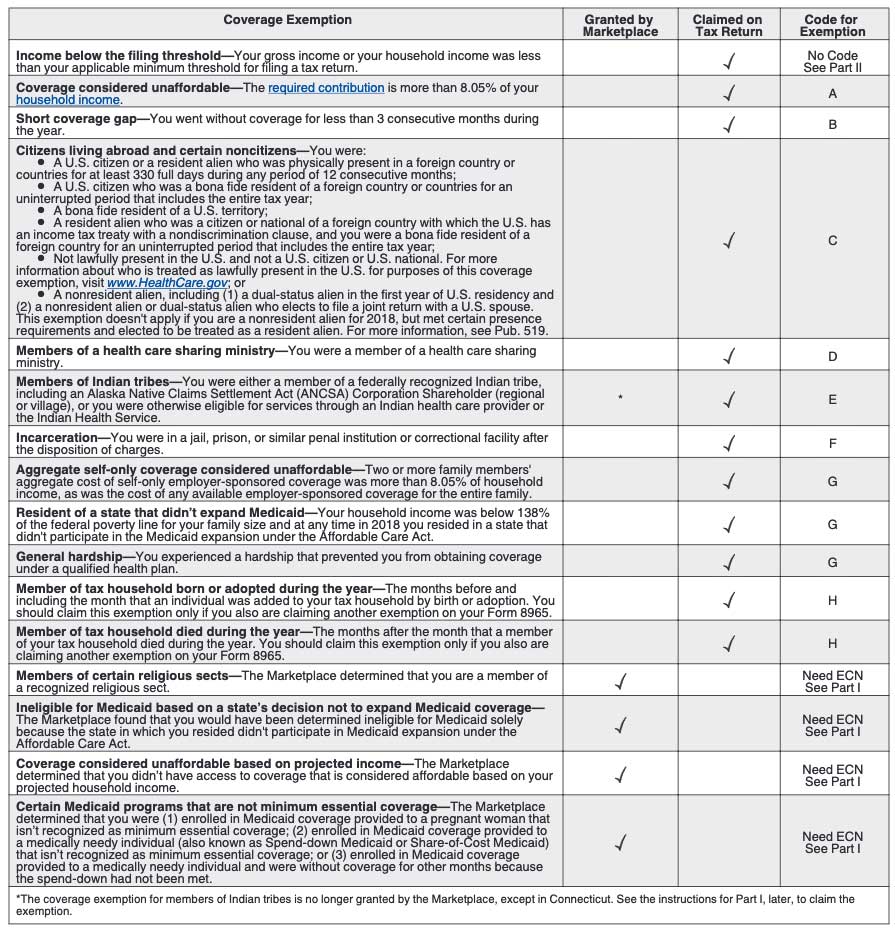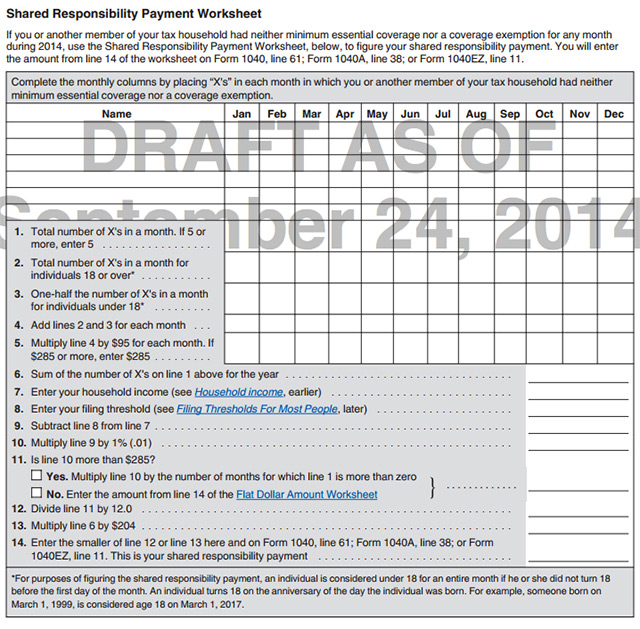
Find out how to fill out Form 8965, Health Coverage Exemptions, the form for reporting ObamaCare Exemptions. We provide a simplified breakdown of form 8965.
Due to changes in the tax structure under Trump there will be no federal fee for not having health coverage in most states for 2019 forward, thus exemptions won’t be as important 2019 forward.
Due to Trump’s orders, for those who didn’t have coverage in 2016 and didn’t have an exemption (and thus would owe the fee): Going Silent on line 61 was an Option in 2016 (this could still result in a fee down the road). This rule does not apply to future years, although the federal fee for not having coverage is reduced to $0 for plans held in 2019 forward.
Didn’t get your ECN yet? Don’t worry! Just enter “PENDING” instead of your exemption number.Here are the official IRS form and the instructions for 8965 for 2015 coverage. See below for a simplified breakdown of form 8965.
You’ll use form 8965 to report exemptions and to help you calculate the Shared Responsibility Payment on your 1040.
IMPORTANT: The instructions for 8965 contain a Shared Responsibility Payment Worksheet, which tells you how to find out if you owe the fee. This is, in part, because you only owe the fee for months that you didn’t have an exemption or coverage.
TIP: To fill out form 8965, you’ll want to have completed your 1040 and have your 1095 on hand. Please note you’ll need a Schedule 4 if you have to make a payment due to not having an exemption.
Anyone who didn’t maintain coverage throughout the entire year needs to fill out an 8965 form.
Some exemptions require an Electronic Confirmation Number from the Health Insurance Marketplace. These reforms typically require proof and the submission of an application. This documentation should be done at the time of the cause of exemption.
Some exemptions last all year, others only last 3 months. Not all exemptions exempt you from the fee; some only initiate a special enrollment period.
Exemptions that don’t require confirmation numbers, such as short-term coverage gaps and affordability exemptions, can simply be claimed on this form. You won’t owe the fee for any months in which you have an exemption. However, you can technically have an exemption and still have coverage, and even cost assistance, in the same month.
See more on ObamaCare’s exemptions or read below for details, including the chart of all exemptions, as they apply to the 8965 form.
As long as you enrolled in a Marketplace in 2014, you are allowed up to four consecutive months (January, February, March, and April) without coverage for 2014 only. Moving forward, you are only allowed three. If you get covered by January 1st, you can use that coverage gap exemption at another point in the year.
To determine if you are eligible for an affordability exemption, you can use the lowest cost silver plan tax tool found here. If the lowest cost silver plan on the Marketplace would cost more than roughly 8% of your household income for self-only (or average aggregate) coverage, then you are exempt. That page also includes a tool for figuring out the second lowest cost sliver plan.

ACA exemptions for the 2018 plan year.
IMPORTANT: Some specifics may change each year, but the general information below should be true in any year. Please use the current official instructions when filing taxes.
Depending upon the type of exemption you have, you’ll either fill out Part I, Part II, or Part III.
If you or a member of your tax household have an exemption granted by the Marketplace, complete Part I
Line 1-6 Name, SSN, and ECN. Here you will report each person and the Electronic Confirmation Number (ECN) you received when you claimed your exemption through the marketplace. If you didn’t need to apply for an exemption, you’d claim that in the next section.
Line 7 Income below filing threshold. You’ll use line 7 a and b to report that you are claiming an exemption because you are below the tax filing threshold. A is for regular exemptions based on income, B is for a hardship exemption based on income.
If you or a member of your tax household are claiming an exemption on your return, complete Part III.
Here you will report an exemption that doesn’t require an Electronic Confirmation Number for each month, or if applicable, the full year.
If you had health coverage or an exemption, simply check the “Full-year health care coverage or exempt” box on your 1040.
If you took an exemption, make sure to attach your 8965 form when you file your taxes.
If you can’t check the box, you generally must report a shared responsibility payment on Schedule 4.
There is no Shared Responsibility Form. The amount is derived from the Shared Responsibility Payment Worksheet, found on form 8965 instructions, and is reported on a 1040 Schedule 4.
This is the last ACA-related thing you will fill out since it requires knowing information from other forms first. The image below is a draft. The actual instructions have not yet been released.
TIP: The worksheet below is a draft, you can find this year’s sheet in the 8965 instructions as noted above.

![]()
ObamaCare Taxes: Form 8965, Health Coverage Exemptions
Thomas DeMichele is the head writer and founder of ObamaCareFacts.com, FactsOnMedicare.com, and other websites. He has been in the health insurance and healthcare information field since 2012. ObamaCareFacts.com is a.
ObamaCareFacts is a free informational site. It's privately owned, and is not owned, operated, or endorsed by the US federal government or state governments. Our contributors have over a decade of experience writing about health insurance. However, we do not offer professional official legal, tax, or medical advice. See: Legal Information and Cookie Policy. For more on our company, learn About ObamaCareFacts.com or Contact us.